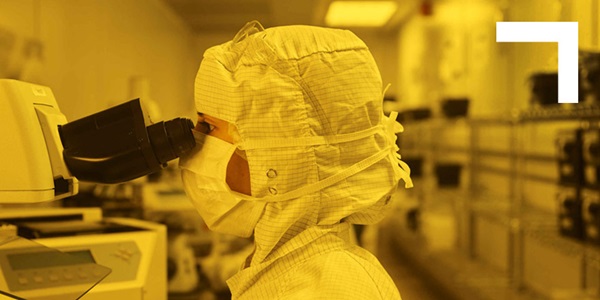The Sound of Future Applications for Field-Induced Forces

By Albert McKeon
You might not hear any sound in Northrop Grumman's Emerging Capabilities Development lab, but Sam Wanis and his colleagues are indeed making noise as they develop future applications that use field-induced forces (FIF).
A field-induced force is almost exactly what the name implies: a wave creates a force that moves an object without touching it. In Wanis' line of work, that force comes from sound. A subset of FIF is the well-known acoustic levitation technique in physics where forces generated from a sound field can balance out the force of gravity. Using frequencies beyond what humans can hear, the sound his team creates can move tiny particles. Wanis uses the high frequencies to perform tasks that are otherwise difficult, costly or could potentially degrade an expensive delicate surface.

Using Sound to Make Shapes
Wanis has been experimenting with acoustic-shaping functions for more than two decades, ever since he first attended Georgia Institute of Technology, where he earned a bachelor's and master's degree as well as a doctorate in aerospace engineering. While at Georgia Tech he used sound to pattern Styrofoam particles in the centimeter to millimeter range into different shapes. His thesis studied the use of such a capability to create noncontact 3D directed assembly as a flexible fabrication tool in microgravity. Now a senior research and development manager for Northrop Grumman, he's always looking for new ways to apply a field induced force, and he recently devised two uses that could reshape undersea imaging and space exploration.
FIF in Space: Energy Created by Sound Moves Dust before Launch
As concertgoers know firsthand, sound has the power to move; music can inspire people to clap, dance and jump for joy. Yet Wanis takes a whole other approach to sound and motion: he uses the energy created by sound to move objects.
When it comes to delicate equipment, you typically can't just pull out a DustBuster to remove particles. When dust particles, for example, accumulate on the surface of a telescope mirror that's headed for space, other means of "dusting" have to be considered. Particles on these delicate mirrors redirect the light they are looking for and thus degrade the science that can be obtained.
"What you need on any large space asset is non-contact surface cleaning," Wanis said. Field induced forces have the potential to be the ideal touchless cleaner, he said.
Most field induced forces research and how it can manipulate and move matter has focused on either waves created by acoustics or electromagnetic energy, according to Wanis. He researches acoustic field induced forces and believes it can replace more harmful and less effective cleaning methods, such as jets of liquid CO2. Even if applied with a steady hand and eye, CO2 doesn't quite control the movement of unwelcome particles which can re-adhere to another part of the mirror and also introduce unwanted thermal stresses to the mirrors delicate surface.
"The problem is you don't know where the particle is going," Wanis said of traditional cleaning methods. "It could be going further down the surface. The group that does contamination control will evaluate any contamination particles during inspection and sometimes decide to leave it there and not recognize it. While they would like to remove all contamination particles some are left to avoid putting stress on the mirror from the liquid CO2."
Wanis' experiments successfully pinned down and moved particles that range from 200 down to 2 microns or smaller. The particles no longer move freely but are instead trapped in the acoustic field. No object touches the particles since the force comes from the acoustic field itself as they are safely steered away from the surface. "We introduced our own particles on a sample test surface and showed they can be removed from the surface and isolated without ever touching the surface," he said.
"It would be great if you can do this at a large scale and not introduce something that's not known to the surface," Wanis added. He and his team continue researching this use of field induced forces, but he is already convinced it could help clean and preserve large telescopic surfaces on satellites just before launch.

Clearing an Underwater Path
Wanis' research always has him thinking about future field induced forces applications. For example, while attending a conference, he learned that military divers can't see certain objects when water is murky due to turbidity, and he instantly thought field-induced forces could clear their line of sight if we could only move them slightly out of the way and create clear lanes in between.
"For underwater divers, it's sometimes hard to read something when the environment is too degraded for visual access," he said. "They have to ask, 'Is this a mine? Or is this a discarded scrap object floating by?' In certain missions the water turbidity is so high that they can touch something with their nose and still can't read it. And the more light you use, the more backscatter occurs due to the particles causing turbidity, and it's harder to see just like in a fog."
Field-induced forces could clear a path for the divers, Wanis thought as he listened to a talk outlining the problem at the conference. "It's impossible to move all the particles out of the way, but wouldn't it be great to create optimal windows for the divers to see through the turbidity? It's almost like creating pockets of clean air between fog. At a distance from an array, a fancy word for 'speakers,' you could create an induced force to move the particles just slightly out of the way leaving clean clear water in between."
The military uses image processing algorithms to improve pictures and videos taken in murky water, but the problem is the starting image is sometimes too degraded for image processing to have much success, Wanis said. With field-induced forces, he said, the images would appear clearer in regions where the turbidity particles have been cleared so the initial pictures would no longer need adjusting; the view itself would be clear. Or the starting image would be much better to yield the image processing more effective - by order orders of magnitude.
"This is still on the research side, but initial proof of concept experiments show great promise," he said. "We're very excited about it."
More innovation stories
Read all stories about advanced technology and innovation >>


